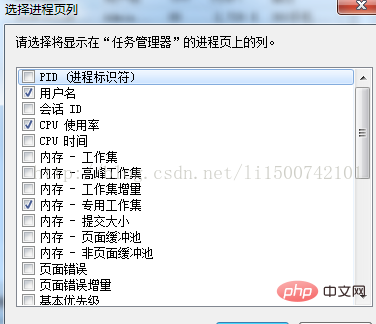Why is the PHP installation port occupied?
Solution to the occupied port when installing PHP: 1. Enter the cmd command in "Run"; 2. Enter "netstat -ano" to check the port occupancy; 3. Find the port occupied in the process manager Process; 4. Unoccupy.

The operating environment of this article: Windows7 system, PHP7.1, Dell G3 computer.
Why is the PHP installation port occupied?
Solution to setting up a PHP server where port 80 is occupied
When encountering the problem that apache cannot start, first consider two points:
1. apache Configuration errors are common among students who have modified the apache configuration file (httpd.conf) without authorization.
2. Port occupation. At this time, students should close all programs that may occupy port 80, such as Thunder, because the default port of wamp is port 80. The most common system program on the server occupies port 80
Note: If you install wamp multiple times, you need to delete the redundant wamp, otherwise it will not start.
Steps:
1: Check what process is occupying port 80
1. Start》Program》Run》Enter cmd command》Press Enter key Start》Program》 Run》Enter cmd command》Press Enter

The above interface appears
2. Enter netstat -ano in the black window to check the port occupancy Situation

Then in front of us will be a long form, the first column of which is the local address, such as 127.0.0.1:987, and the previous string is The IP address, the one after the colon is the port being occupied. We need to find the line for port 80 and write down its PID. For example, in the line of port 445 in my picture, its pid is 4.
two. Find the process occupying the port in the process manager
1. Start》Program》Run》taskmgrOpen the process manager

Process tab There is no item PID, solution: View》Select column

option to get
result
##3. Release the occupation
1.
If the port is occupied by an application, you can directly end the process2.
If the port is occupied by a system process,

This process cannot be terminated. Termination will result in a blue screen or shutdown. The solution is:
In
CMD# In the input box of##, enter: RegEdit, press Enter, and find HKEY_LOCAL_MACHINE\SYSTEM\CurrentControlSet\Services\HTTP
Find a DWORD
valueStart, change it to 0 Restart the computer, Well, the System
process will not occupy the 80 port. Recommended learning: "PHP Video Tutorial
The above is the detailed content of Why is the PHP installation port occupied?. For more information, please follow other related articles on the PHP Chinese website!

Hot AI Tools

Undresser.AI Undress
AI-powered app for creating realistic nude photos

AI Clothes Remover
Online AI tool for removing clothes from photos.

Undress AI Tool
Undress images for free

Clothoff.io
AI clothes remover

AI Hentai Generator
Generate AI Hentai for free.

Hot Article

Hot Tools

Notepad++7.3.1
Easy-to-use and free code editor

SublimeText3 Chinese version
Chinese version, very easy to use

Zend Studio 13.0.1
Powerful PHP integrated development environment

Dreamweaver CS6
Visual web development tools

SublimeText3 Mac version
God-level code editing software (SublimeText3)

Hot Topics
 1386
1386
 52
52
 PHP 8 JIT (Just-In-Time) Compilation: How it improves performance.
Mar 25, 2025 am 10:37 AM
PHP 8 JIT (Just-In-Time) Compilation: How it improves performance.
Mar 25, 2025 am 10:37 AM
PHP 8's JIT compilation enhances performance by compiling frequently executed code into machine code, benefiting applications with heavy computations and reducing execution times.
 OWASP Top 10 PHP: Describe and mitigate common vulnerabilities.
Mar 26, 2025 pm 04:13 PM
OWASP Top 10 PHP: Describe and mitigate common vulnerabilities.
Mar 26, 2025 pm 04:13 PM
The article discusses OWASP Top 10 vulnerabilities in PHP and mitigation strategies. Key issues include injection, broken authentication, and XSS, with recommended tools for monitoring and securing PHP applications.
 PHP Secure File Uploads: Preventing file-related vulnerabilities.
Mar 26, 2025 pm 04:18 PM
PHP Secure File Uploads: Preventing file-related vulnerabilities.
Mar 26, 2025 pm 04:18 PM
The article discusses securing PHP file uploads to prevent vulnerabilities like code injection. It focuses on file type validation, secure storage, and error handling to enhance application security.
 PHP Encryption: Symmetric vs. asymmetric encryption.
Mar 25, 2025 pm 03:12 PM
PHP Encryption: Symmetric vs. asymmetric encryption.
Mar 25, 2025 pm 03:12 PM
The article discusses symmetric and asymmetric encryption in PHP, comparing their suitability, performance, and security differences. Symmetric encryption is faster and suited for bulk data, while asymmetric is used for secure key exchange.
 PHP Authentication & Authorization: Secure implementation.
Mar 25, 2025 pm 03:06 PM
PHP Authentication & Authorization: Secure implementation.
Mar 25, 2025 pm 03:06 PM
The article discusses implementing robust authentication and authorization in PHP to prevent unauthorized access, detailing best practices and recommending security-enhancing tools.
 How do you retrieve data from a database using PHP?
Mar 20, 2025 pm 04:57 PM
How do you retrieve data from a database using PHP?
Mar 20, 2025 pm 04:57 PM
Article discusses retrieving data from databases using PHP, covering steps, security measures, optimization techniques, and common errors with solutions.Character count: 159
 PHP CSRF Protection: How to prevent CSRF attacks.
Mar 25, 2025 pm 03:05 PM
PHP CSRF Protection: How to prevent CSRF attacks.
Mar 25, 2025 pm 03:05 PM
The article discusses strategies to prevent CSRF attacks in PHP, including using CSRF tokens, Same-Site cookies, and proper session management.
 What is the purpose of mysqli_query() and mysqli_fetch_assoc()?
Mar 20, 2025 pm 04:55 PM
What is the purpose of mysqli_query() and mysqli_fetch_assoc()?
Mar 20, 2025 pm 04:55 PM
The article discusses the mysqli_query() and mysqli_fetch_assoc() functions in PHP for MySQL database interactions. It explains their roles, differences, and provides a practical example of their use. The main argument focuses on the benefits of usin




